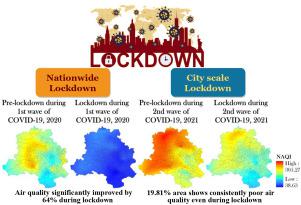Urban Climate ( IF 6.0 ) Pub Date : 2022-01-06 , DOI: 10.1016/j.uclim.2021.101082 Susanta Mahato 1 , Swades Pal 2

|
Is the impact of city-scale lockdown in response to 2nd surge of COVID-19, behavioural changes in people owing to yearlong cohabitation with COVID-19, and partial vaccination on air quality different from the impact of nationwide lockdown during COVID-19's 1st surge in March 2020? Targeting this objective, the present work has selected four phases pre-lockdown and lockdown of 1st and 2nd cycles of lockdown taking average air quality index (NAQI) from Central Pollution Control Board (CPCB). The results clearly show that both the nationwide lockdown and the city-scale restriction are responsible for improving air quality in India's megacity Delhi, but the rate of improvement was higher (39%) during the first cycle of lockdown (nationwide) than during the second cycle of lockdown (city-scale). During city-scale lockdown, the disparity in NAQI between the core and the periphery is obvious. Due to the effect of economic activities surrounding Delhi, around 10 km of the city's interior has experienced high NAQI. The reason for the lower NAQI improvement during the second lockdown cycle is likely due to relief from initial fear following a year of cohabitation with COVID-19, partial vaccination, and partial relaxation in industrial sectors to avoid the economic hardships experienced during the first lockdown cycle.
中文翻译:

印度大城市德里新冠肺炎 (COVID-19) 疫情第二次激增,重新审视封锁期间的空气质量
为应对 COVID-19 第二次激增而实施的城市范围封锁、因与 COVID-19 共居一年而导致的人们行为变化以及部分疫苗接种对空气质量的影响与 COVID-19 第一次激增期间全国封锁的影响是否不同2020 年 3 月?针对这一目标,目前的工作选择了四个阶段的预封锁和第一和第二封锁周期的封锁,并采用中央污染控制委员会(CPCB)的平均空气质量指数(NAQI)。结果清楚地表明,全国范围内的封锁和城市规模限制都对改善印度特大城市德里的空气质量负有责任,但第一个封锁周期(全国范围内)的改善率 (39%) 高于第二个封锁周期锁定周期(城市规模)。在城市范围内的封锁期间,核心区和外围区的NAQI差距很明显。由于德里周边经济活动的影响,该市内陆约10公里范围内出现了较高的NAQI。第二个锁定周期期间 NAQI 改善较低的原因可能是由于与 COVID-19 共存一年后最初的恐惧得到缓解,部分疫苗接种以及工业部门的部分放松以避免第一个锁定周期期间经历的经济困难。











































 京公网安备 11010802027423号
京公网安备 11010802027423号